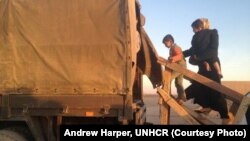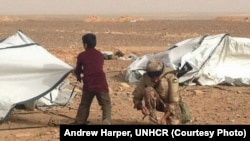Syrian refugees have been pouring into Jordan since 2011, most of them from southern cities of Daraa or Damascus. But U.N. officials say the latest waves of Syrian refugees are coming much further way.
And Andrew Harper, coordinator for the U.N. High Commission for Refugees (UNHCR), says this is a sign that is deeply distressing.
“We are getting hundreds of refugees coming in new routes, like from Homs and Hama, which we have never seen before, under extremely difficult circumstances,” Harper said.
To avoid the ongoing violence in Damascus and other southwestern cities, the refugees have been traveling southeast toward the Jordan’s eastern border with Iraq. There, they park their cars and cross over the border by foot into Jordan.
At this time of year, crossing is still comfortable during the day, though that will change as the summer approaches. At night, the refugees have only the stars to guide them. There is little water in this part of Jordan; it has to be trucked in. There is no electricity either.
“And so to identify to the refugees when they are crossing at night where Jordan is, the armed forces are flashing their patrol lights through the darkness to the refugees, signaling that this is the way they have to come,” Harper said. “It’s almost like setting up a lighthouse beacon.”
Six, seven even eight hours later, the lucky ones are rescued by Jordanian border patrols. But they still have a long way to go before they reach the Zaatari refugee camp at Al Mafraq.
“The border guards don’t have the funds to put enough petrol in the vehicles to keep these vehicles doing the round trips to the camp and back,” Harper said. “They don’t have four-wheel-drive buses, and the poor Jordanian armed forces only have two trucks in one post, three trucks in another post, and we’re trying to figure out, ‘How the hell do we get ready to receive thousands more people coming through this route?’”
Families, often unaccompanied women and children, are loaded into the backs of trucks to begin another trek, as long as 400 kilometers.
“So you have children who have already suffered, coming across in the night in the desert, in the dust, who are then having to be put into these trucks for nine hours to get to safety, and these trucks are sort of just plowing through sand and dust, billowing around, trying to survive,” Harper said.
Once the Jordanian patrols have dropped the refugees off at Zaatari, they turn around and head back to the eastern border to rescue still more refugees — some of them injured, most of them exhausted and frightened. There are hundreds a day and their numbers are growing.
“We know that we are going to be continuing to see tens of thousands, if not hundreds of thousands of Syrians coming towards Jordan,” says Harper, “And we need to ensure that we’ve got the necessary resources to be able to put in place an infrastructure. We need to be building more camps. But we don’t have the money.”
Zaatari hosts about 100,000 refugees today, but any more and it could become unmanageable. For now, says Harper, there are enough tents, food, water and health care. There have been no serious outbreaks of disease, but that could change at any time.
Harper praises Jordan as a perfect and generous host to refugees.
“It has hosted a couple of million Palestinians. It has hosted hundreds of thousands of Iraqis," he says. "It’s now being inundated by Syrians.”
Jordan has allocated land for another refugee camp, assuming there will someday be funds to build it. But any additional refugee camps will need more water, which already is in short supply. Jordan has also been allowing Syrians to access the health system, the education system. But sadly, says Harper, that isn’t enough.
It’s up to the international community, he says, to turn “magnificent gestures of solidarity towards refugees” into something more practical.
And Andrew Harper, coordinator for the U.N. High Commission for Refugees (UNHCR), says this is a sign that is deeply distressing.
“We are getting hundreds of refugees coming in new routes, like from Homs and Hama, which we have never seen before, under extremely difficult circumstances,” Harper said.
To avoid the ongoing violence in Damascus and other southwestern cities, the refugees have been traveling southeast toward the Jordan’s eastern border with Iraq. There, they park their cars and cross over the border by foot into Jordan.
We know that we are going to be continuing to see tens of thousands, if not hundreds of thousands of Syrians coming towards Jordan...We need to be building more camps. But we don’t have the money.UNCHR Humanitarian Coordinator Andrew Harper
“And so to identify to the refugees when they are crossing at night where Jordan is, the armed forces are flashing their patrol lights through the darkness to the refugees, signaling that this is the way they have to come,” Harper said. “It’s almost like setting up a lighthouse beacon.”
Six, seven even eight hours later, the lucky ones are rescued by Jordanian border patrols. But they still have a long way to go before they reach the Zaatari refugee camp at Al Mafraq.
“The border guards don’t have the funds to put enough petrol in the vehicles to keep these vehicles doing the round trips to the camp and back,” Harper said. “They don’t have four-wheel-drive buses, and the poor Jordanian armed forces only have two trucks in one post, three trucks in another post, and we’re trying to figure out, ‘How the hell do we get ready to receive thousands more people coming through this route?’”
Families, often unaccompanied women and children, are loaded into the backs of trucks to begin another trek, as long as 400 kilometers.
“So you have children who have already suffered, coming across in the night in the desert, in the dust, who are then having to be put into these trucks for nine hours to get to safety, and these trucks are sort of just plowing through sand and dust, billowing around, trying to survive,” Harper said.
Once the Jordanian patrols have dropped the refugees off at Zaatari, they turn around and head back to the eastern border to rescue still more refugees — some of them injured, most of them exhausted and frightened. There are hundreds a day and their numbers are growing.
“We know that we are going to be continuing to see tens of thousands, if not hundreds of thousands of Syrians coming towards Jordan,” says Harper, “And we need to ensure that we’ve got the necessary resources to be able to put in place an infrastructure. We need to be building more camps. But we don’t have the money.”
Zaatari hosts about 100,000 refugees today, but any more and it could become unmanageable. For now, says Harper, there are enough tents, food, water and health care. There have been no serious outbreaks of disease, but that could change at any time.
Harper praises Jordan as a perfect and generous host to refugees.
“It has hosted a couple of million Palestinians. It has hosted hundreds of thousands of Iraqis," he says. "It’s now being inundated by Syrians.”
Jordan has allocated land for another refugee camp, assuming there will someday be funds to build it. But any additional refugee camps will need more water, which already is in short supply. Jordan has also been allowing Syrians to access the health system, the education system. But sadly, says Harper, that isn’t enough.
It’s up to the international community, he says, to turn “magnificent gestures of solidarity towards refugees” into something more practical.










